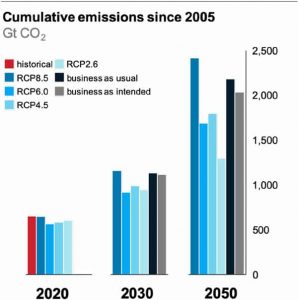The RCP 8.5 CO2 emissions pathway, long considered a “worst case scenario” by climate scientists, is the most appropriate for conducting assessments of climate change impacts by 2050, according to a paper published this week in the Proceedings of the National Academy of Sciences.
A number of recent articles have dismissed RCP 8.5 as alarmist or misleading, but it is actually the closest approximation of both historical emissions and anticipated outcomes of current global climate policies, tracking within 1% of actual emissions.
The authors, from the Woods Hole Research Center in Massachusetts, write:
“Climate simulation-based scenarios are routinely used to characterize a range of plausible climate futures. Despite some recent progress on bending the emissions curve, RCP8.5, the most aggressive scenario in assumed fossil fuel use for global climate models, will continue to serve as a useful tool for quantifying physical climate risk, especially over near- to midterm policy-relevant time horizons.
“Not only are the emissions consistent with RCP8.5 in close agreement with historical total cumulative CO2 emissions (within 1%), but RCP8.5 is also the best match out to midcentury under current and stated policies with still highly plausible levels of CO2 emissions in 2100.”
Four scenarios known as Representative Concentration Pathways (RCPs) were developed in 2005 for the Intergovernmental Panel on Climate Change. The RCP scenarios are used in global climate models; they include historical greenhouse gas emissions until 2005, and projected emissions subsequently. RCP 8.5 assumes the greatest fossil fuel use, and a resulting additional 8.5 watts per square meter of radiative forcing by 2100.
While there are signs of progress on bending the global emissions curve and the emissions picture may change significantly by 2100, focusing on the unknowable, distant future may distort the current debate on these issues.
“For purposes of informing societal decisions, shorter time horizons are highly relevant, and it is important to have scenarios which are useful on those horizons. Looking at mid-century and sooner, RCP8.5 is clearly the most useful choice.”
RCP 8.5 would not be significantly impacted by the Covid-19 pandemic. “Assuming pandemic restrictions remain in place until the end of 2020 would entail a reduction in emissions of -4.7 Gt CO2. This represents less than 1% of total cumulative CO2 emissions since 2005 for all RCPs and observations.”
The paper concludes:
“Given the agreement of 2005-2020 historical and RCP8.5 total CO2 emissions and the congruence between current policies and RCP8.5 emission levels to mid-century, RCP8.5 has continued utility, both as an instrument to explore mean outcomes as well as risk.
“Indeed, if RCP8.5 did not exist, we’d have to create it.”
This article includes material provided by Woods Hole Research Center.



